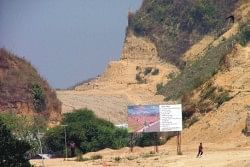Cutting hills: Why and why not

Bangladesh is mainly a deltaic plain of the Ganges and the Brahmaputra river systems. However, we have some tertiary upland in the northwest and some hills and hillocks in the southeastern area. Hills, plains and river basins -- all are created naturally; unfortunately, the mankind realizes their essentiality at least after doing much harm to the natural ecosystems.
What is the actual use of such uneven land masses? The Great Creator says: “And He has cast great mountains in the earth lest it might be convulsed with you, and rivers and roads that you may go aright” (The Quran: 16.15). Scientifically we still do not know how mountains and hills arrest probable convulsion and ensure stability to the earth. But we know for certain that such elevated land increases the surface area of the earth and also that there are some special types of flora and fauna that exclusively grow and survive in these high lands. So cutting or razing them to ground obviously destroys those species that one way or other help our own survival.
Realizing the importance of hills, the Government of Bangladesh formulated some rules to protect them. Since hill razing is often associated with building human dwellings, the rules mainly concerned building construction. The Building Construction Rules 1996 have specific provisions regarding the permission procedure for hill cutting. Of these, Rule 27 states that in addition to the fees and designs as required under the Rules, the applicant must also submit: a) clearance or NOC (No Objection Certificate) from the environment department; (b) topographical or contour map of the hill; and (c) detailed design showing all the necessary development plan, protective measures etc. Following all these rules, nobody can actually raze hills and build houses.
Then why some people are still up and doing in razing hills? The people who cut hills have their own logics to show. The main reason they show is that humans need plain land to cultivate crops and build houses. Since we, in Bangladesh, are too many people we have more rights (!) to raze hills for our survival? Conserving natural hills, forests and the biota may appear luxury to them. Some even may claim that they are developing 'real estates' (buildings) out of the natural unreal (!) and virtually unused (fallen!) wealth. I am tempted to quote few lines from a letter published in The Daily Star in January this year. “Even if all the hills of the CHT and Sylhet are razed there should not be significant change in climatic conditions in Bangladesh” (Md. Ashraf Hossain, Razing hills, 25/01/2008). The letter writer's known only purpose of conserving hills would have been to protect the prevailing climatic conditions through increased rains that to his understanding was not contributed by hills. Therefore he found no reason for the government's enacting laws against razing hills and asked the government to review the situation and repeal the Act and encourage public and private sector to develop plain land to cater to the need for farmland.
I appreciate Mr. Hossain's concern for more 'farmlands' for the country's increasing population. He has given the notion quite freely (without prejudice) and asked for scientific explanation from the public who knows. I have tried here to provide some explanations and specifically mentioned two points: 1) hills have increased the surface area substantially and made more rooms for growing 'forest crops', if not cereals; 2) these harbour certain species of plants and animals that would otherwise become extinct.
Regarding extinction of biota, we have lost a number of animal species who were forest dwellers. We have lost much more plant species and grew some monoculture forests in some smaller specific locations. Thus we are making a bloom of humans in expense of many other species only to die like the well-known algal bloom that dies down in few years. We can't and should not proceed towards such an end. We need to slow down our own growth rate and arrest the razing of hills as a contributory factor.
Hill cutting is known to be rampant in Khagrachhari district and in the Chittagong metropolitan city itself. It is known to all that human (especially poor) dwellings near the hill slopes are in danger of landslide that killed a number of persons last year. If extending the city towards the north engulfing the hills and hillocks cannot be stopped at all, we can just follow the norm prevailing in East Asian rapidly developing countries like Singapore and Malaysia.
was sent to University Malaya (UM) in 2002 for some training in curriculum matters. I noticed some buildings of UM were two storied in one side and four storied on the other. The 'real estate' developers there kept the hillock intact and built the building over the uneven land. The same is true for raising buildings in Singapore. In the National Institute of Education, most buildings are three storied in the centre and six storied on the sides of the hillock. There are a number of engineering schools in Nanyang Technological University in Singapore where some buildings are in the valley, some in the slopes and some others over the hillock. There is no engineering problem in raising buildings over uneven land base. So let us be wiser and build houses over uneven land in Chittagong at least to save people from landslide and in other areas, conserve hills and forest just to save ourselves (if you have no feelings for other animals and plants) in the long run.

 For all latest news, follow The Daily Star's Google News channel.
For all latest news, follow The Daily Star's Google News channel. 



Comments